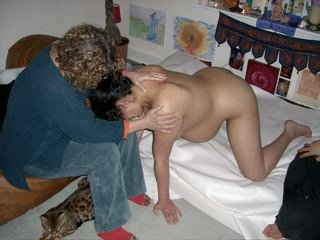I often get asked; Ecstatic Birth, is that like hypnobirthing?
No, not really from what I can tell. The emphasis with hypnobirthing seems to be on minimalising the intensity of birth. Instead of contractions, we’ll call them waves or surges. We won’t mention the words pain or fear, but instead focus on the positive. But my experience in hypnobirthing is limited to having heard a few tapes and doing a fair amount of plain old hypnosis. I may have this completely wrong and if that is the case, I’d love to hear from any practitioners/mothers who can enlighten me.
Throughout pregnancy and particularly when a woman enters the altered state of labour, releasing hormones, endorphins and even the psychedelic chemical DMT, any underlying fears and negative beliefs can start to manifest in the environment around her. If she has been avoiding these fears by focusing only on what is positive and affirming, she may get railroaded by them. Ecstatic Birth is about addressing fear at the root cause, (which is the impact of her own birth and the beliefs she has taken on about birth and life).
Women who prepare ecstatically, using Binnie Dansby’s approach, look forward to birth as an opportunity to experience their life energy in full technicolour. Some crazy folks invest a lot in getting a rush from paragliding, base jumping or mountain climbing. Here we have this amazing opportunity for exhilaration and empowerment available to us in a normal family event. More importantly, it is an opportunity for profound and fast-track healing of our core wounds that stem from the way we were welcomed to this world.
Hypnobirthing seems to be more about being ‘in control’ and staying calm, than relishing the opportunity to experience and surrender to these higher and higher levels of life energy.
“I used to listen to these tapes to prepare for the birth. My partner would be fast asleep and I’d be lying there twitching and feeling anxious. Hypnobirthing didn’t address the fear and I didn’t feel calm!”
A mother discussing her first pregnancy
During an ecstatic labour, you would actively welcome the intensity. Really allowing and making use of the sensations, rather than concentrating the mind elsewhere. What this means is letting ourselves feel it; letting it expand even if it becomes overwhelming. And just noticing all those feelings with attentive curiosity, yet without taking them too seriously. What are they saying to you?
Another thing we encourage is that the woman keeps expressing how she is feeling, usually between contractions. Verbalising “I’m feeling scared” can be much more useful than allowing her mind, in isolation, to spiral into the fear. She chooses the breath rather than getting involved with emotions that come up. This is a powerful act of autonomy over her fears and conditioning. It says ‘I won’t get involved with these feelings, I get to be in charge of where I direct my energy and I choose to breathe right now.’ Making eye contact with a supporter breaks the illusion of isolation and the belief that ‘I have to do this by myself.’
To the untrained eye an Ecstatic Birth may appear a lot like a couple is using hypnobirthing. One midwife who was at a birth I supported decided to go on and train in hypnobirthing, assuming that was the influence. The mother will be relaxed, possibly chatting between contractions, taking it all in her stride. The difference is she is able to do so because she’s done deep work in preparation that leaves her mostly unafraid and any fears that do come up will be easily expressed and supported.
Often birth is painless or orgasmic when a woman approaches it in this way. She is safe with the energy of birth. Fear is what causes pain and without it, birth is designed to be immensely pleasurable. However Ecstatic Birth is not about having ‘the perfect birth.’ It is about being present with whatever comes up. There will always be echoes back to a couple’s birth and systemic imprint. The more they heal these, the less messily, dramatically and intensely they will show up. By using the immense creative energy available, it is possible to heal these echoes deeply. It may not always be possible to heal so much at a particular point in time that the experience is blissful. Yet if there is pain she still has a choice about how to react to it.
During my first labour I started saying “It hurts” and switched from a powerful, ecstatic place to being in victim consciousness. Predictably the labour became scary from that point and I gave up a lot of my power. The next time round, (which was mostly painless and felt delicious) there was one point where I was tempted to express “It hurts” and I forced myself to instead say “mashed potatoes.” I wasn’t denying the experience of pain, just making a choice not to get involved. “Mashed potatoes” meant fuck yes that was painful and big deal, who gives a shit really? I didn’t. Other powerful words to say are “yes” and “thank you”, especially when you don’t feel like saying them.
Undoubtedly hypnobirthing works for many women. I think there is definitely a place for tools that support those who aren’t willing or able at that point to face some of the scary deeper issues. As a culture we tend to shy away from what’s real and go for a glossed over, safe version. Its an illusion that it’s safer to avoid the hard stuff though. I have seen women getting to a certain point with hypnobirthing and then losing it and screaming for drugs. The real safety comes from addressing why she’s so terrified.

Leave a Reply